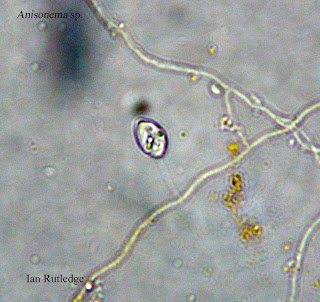It has been 6 days since my last observation and quite a few things have changed within my Microaquarium. As mentioned in my last blog post, a second beta food pellet was added after my last observation 6 days ago and I can say with certainty that it has significantly affected the ecosystem in my Microaquarium. Today I was able to indentify, with Dr. McFarland's help, three new organisms that I hadn't identified in my previous observations, and in general, the abundance and diversity of organisms has increased significantly. This week for the first time I was able to indentify an additional cyclops of equal age but opposite gender to the one previously observed. I also observed a very juvenile cyclops. In addition to the newly identified organisms I was able to observe a swarm of bacteria in my Microaquarium. As I watched, huge numbers of various bacteria of different shapes moved very rapidly and in a sort of collective fashion forming a swarm. The swarm was limited to a vague cylindrical shape, and the whole collection of bacteria seemed to be moving to the right, in affect sweeping the area. Dr. McFarland postulated that it might be related to a biofilm.
Overall it has been amazing to see the ecosystem change over the last few weeks, and witness an environment and the evolution of a food chain first hand. It's been an incredible opportunity to use the equipment of the lab in Hesler biology and see these microscopic processes that take place largely without our knowledge. I have to thank Dr. McFarland for being so accommodating, and meeting with me outside of the normal observation hours.
Picture 1. Cyclops sp. A fully developed cyclops that is probably a male (Pennak, 1953, p. 384 Figure 241).
Picture 2. Raphidiophrys sp. A raphidiophrys, an amoeba, can be seen with microtubule structures extending from its center (Patterson p. 173 Figure 193).
Picture 3. Centropyxis sp. A centropyxis, an amoeba can be seen (Patterson p. 95 Figure 184).
In addition to the organisms pictured above, I was able to identify an Amoeba Radiosa (Patterson p. 80 Figure 142). I was also able to observe an Epalxis sp. (Pennak p. 141 Figure 124).
The following video depicts the bacteria swarm:







